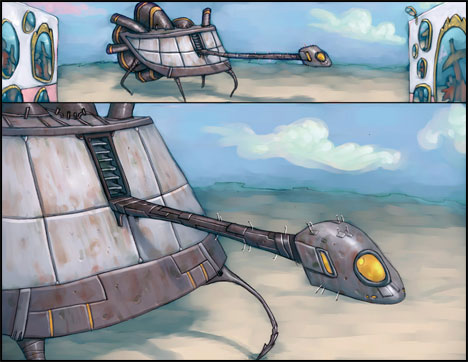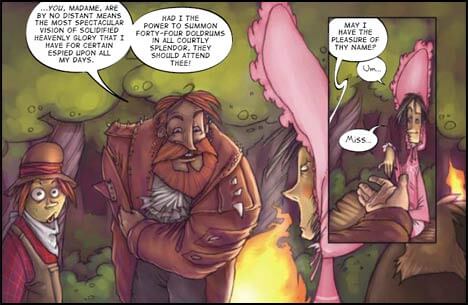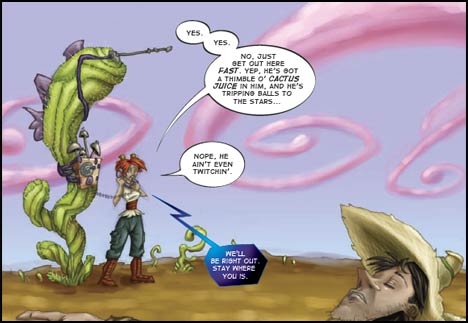Ape Entertainment brings us Josh Wagner’s Fiction Clemens (sub-titled Adventures of a Zen Space Cowboy), a Space Western tale about the inexorable spiral of living. — ed, N.E. Lilly
Fiction Clemens Review
“Ever have a moment that reminds ye of an old forgotten dream? But then maybe the dream were really the memory of a moment ye once lived?”

Christian Olsen came up with the name “Fiction Clemens” and asked his friend Josh Wagner to write a character around it. The character first appeared in The Adventures of the Imagination of Periphery Stowe along with Dune Trixie. After an attempt to make Fiction Clemens into a movie — with a script that called for special effects that would be beyond the reach of most independent film crews — Fiction Clemens became much more budget friendly three part comic.
The comic series starts off with some intentionally corny humor that you can’t help but laugh at. You get the feeling that there’s a bigger world than just the events that are happening in the story. That there are a number of stories going on, some of which are alluded to but you don’t quite see, and that the main plot that the story follows is just a part of it.
The feature plot follows origin of the duo, Fiction Clemens and Dune Trixie, as they drift through the far out West of another planet. Fiction Clemens is accosted by Tiberius Kitchens, and is saved by Dune Trixie. On the run from Tiberius, Fiction and Dune Trixie don disguises. When Tiberius catches up to them, he mistakes Fiction for a woman, and is enraptured by “her” beauty and offers “her” a dowry of Spindle’s Web, a cactus farm. Meanwhile, the elder Kitchens is buying up all the land, so that he can corner the market on toothpicks, and unfortunately Spindle’s Web, which his son has just given away, figures prominently in his plans. The remainder of the plot deals with the consequences, as Tiberius hunts down Fiction Clemens and Dune Trixie, the elder Kitchens tries to corner the toothpick market, and everyone discovers in the end that what they wanted really isn’t what they wanted (for good and for ill).

The artist, Joiton does a wonderful job of capturing the story in a style that reminded me of a mixture of The Maxx, The Nightmare Before Christmas, and Edvard Munch’s The Scream. The best part of Fiction Clemens isn’t the artwork, or the plot, or the characters (which are quite good). No, the best part of Fiction Clemens is actually the craft with which the story is told. It was a poem. There seemed to be an underlying discipline to the way that the story was being told, much in the same way that a haiku or a couplet has a formal structure, and yet an infinite variety of stories can be told in them. It can be summed up in the following panel, from issue #3:

If I could compare the story structure to anything it would be gravity. Too often I’ve seen stories where the characters are pulled along by the events outside of their control. While it’s easy to see how events in Fiction Clemens lead up to the climax, at no time do you feel that the characters are locked into their fate. While some stories inevitably crash (and burn) Fiction Clemens traces a lazy orbit that eventually spirals the scope of the story out, far from the point of origin.
This can be seen especially in the issue #2. The story starts with Fiction passed out on the ground and Dune Trixie calling for help. The story then back tracks to the events leading up to that point, but, just like a spiral, although it returns to the same point it places you further along in the story.

The same can be said for the series as a whole. It ends in the same place where it begins, and yet leaves you further along in the story. Well done!

If you like Space Westerns then you should give Fiction Clemens a look. All three issues are in stores now. You can find more information about Fiction Clemens at the Fiction Clemens website or the Ape Entertainment website.
♠
Other works by N.E. Lilly
- Is Firefly “Out of Gas”? (Dec 12, 2022)
- The Emancipation of Bat Durston, or, “I’m from Iowa, I only work in Outer-space” (Dec 5, 2022)
- Interview with Phil Foglio (Nov 8, 2009)
- 10 Most Influential Space Westerns (Oct 25, 2009)
- Space Western Most Wanted (Jan 25, 2009)
- more by N.E. Lilly

I Love Serenity
Men’s Basic T-Shirt that says “I Love Serenity” in Chinese.
Available from the Space Westerns Magazine Store on Zazzle →

Comments
You are not logged in. Log-in to leave a comment.